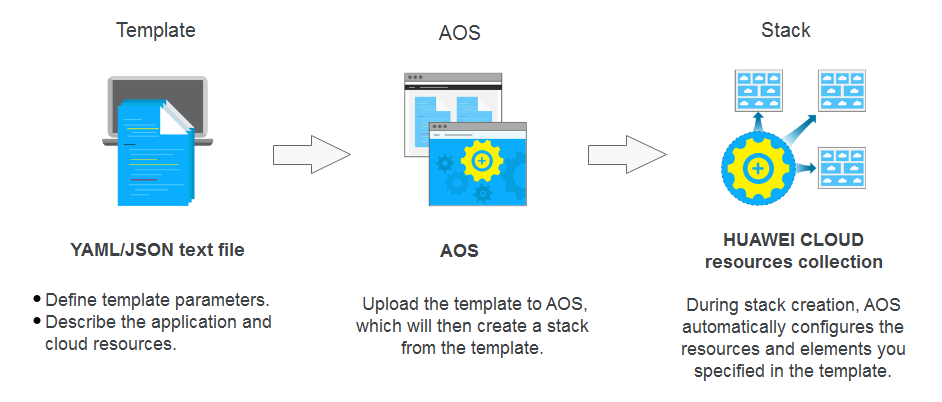Introduction
Application Orchestration Service (AOS) enables enterprises to automate application cloudification. By orchestrating mainstream cloud services of HUAWEI CLOUD, you can create, replicate, and migrate your applications and provision required cloud resources with a few clicks.
To work with AOS, all you need to do is create a template describing the applications and cloud resources that you would like, including their dependencies and references. AOS will then set up these applications and resources as specified in your template. For example, suppose you want to create an Elastic Cloud Server (ECS), together with a Virtual Private Cloud (VPC) and a subnet on which the ECS runs, you simply create a template defining an ECS, a VPC, a subnet, and their dependencies. AOS will then create a stack, namely, a collection of resources you specified in the template. After the stack has been successfully created, the ECS, VPC, and subnet are available to use.
AOS templates are text files that are easy to read and write. You can directly edit template files in YAML or JSON format. In addition, AOS Template Market provides a large volume of free templates, covering common application scenarios, for you to use directly or as references.
AOS manages applications and cloud resources through stacks. Operations like creation, deletion, and replication can be performed on the whole stack as a unit. When creating stacks, AOS automatically set up your applications and required cloud resources as described in your template. The statuses, alarms, and other information on each of the application or resource in your stack can be easily viewed.
You can work with AOS on Console or through API.

Features
- Automatic orchestration of resources
AOS provides automatic orchestration of mainstream HUAWEI CLOUD services. For details, see Cloud Services and Resources that Can Be Orchestrated in AOS. AOS also provides lifecycle management including resource scheduling, application design, deployment, and modification to reduce O&M costs through automation.
- Hybrid orchestration of applications and cloud service resources
You can use standard languages, namely YAML and JSON, to describe required basic resources, application systems, upper-layer services, and their relationships. Based on your description, resource provision, application deployment, and service loading can be automatically performed in the order specified by dependencies with a few clicks. You can perform unified management on deployed resources and applications like deletion, scaling, replication, and migration.
- Abundant application templates provided
AOS Template Market provides abundant templates for free, including basic resource templates, service combination templates, and industry templates, covering common application scenarios. You can use these public templates directly to deploy cloud-based services in seconds.
Feedback
Was this page helpful?
Provide feedbackThank you very much for your feedback. We will continue working to improve the documentation.See the reply and handling status in My Cloud VOC.
For any further questions, feel free to contact us through the chatbot.
Chatbot








